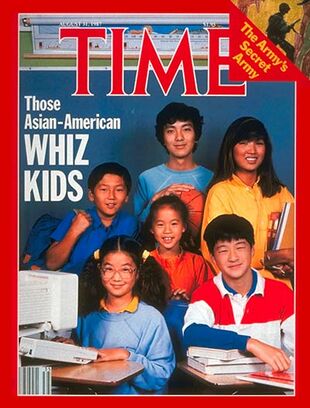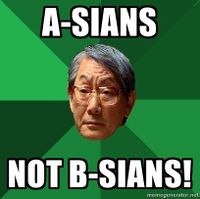The Model Minority Myth

Definition of a Model Minority
A model minority is a minority group, usually by ethnicity, gender, or religion, whose members are believed to achieve higher socioeconomic status than the average person. This socioeconomic success is typically measured by education level, income, crime rates, and family stability. The term was originally coined by sociologist William Petersen in 1966 in an article he wrote for the New York Times Magazine to describe Japanese-Americans as having strong work ethic and family values, allowing them to achieve success parallel to Jewish-Americans despite having faced "the most discrimination and the worst injustices... to persons alive today". He argues that these characteristics raise them above the ranks of other "problem minorities" [1]. Currently in North America this perception of the model minority has expanded to include most people of Asian descent, but particularly those of East-Asian and South-Asian descent [2][3].
Perpetuating the Myth

Chinese and Japanese-Americans were the first to be molded in the model minority image following Petersen's essay and subsequent similar articles in Times Magazine and U.S. News and World Report lauding them for their immigrant success stories, sharing implications that their achievements were attributed to successful assimilation into American society and "good" cultural values. They used U.S. census data to support their claims that through hard work and minding their own business, Asian-Americans were able to attain higher education, more professional occupations, higher incomes, and lower rates of crime and mental illness [4].

In 1997, 1300 prime time television advertisements were analyzed for ethnic representation, showing that Asian models were overrepresented in proportion to the population as a whole (8.4% to 3.6%), but they were more likely to be in background roles than other minority groups. Asian women in particular were relegated to reduced roles. Asian models were also mostly depicted emphasizing their strong work ethics, with almost no representation of social or personal lives [5]. This portrayal continued into the 2000's, with even magazines with high Asian-American readerships reflecting the same stereotypes of passive, technology savvy, business oriented Asians. Asian models continued to be underrepresented in social settings and family settings, as well as in advertisements for toys, clothing, food [6]. Asians in North America were presumed to be too focused on business to have social lives, instead looking to economic achievement for fulfillment [4].
With the shift in media consumption to the internet, memes such as High Expectations Asian Father and Level: Asian emphasized myths of East-Asian superior studiousness and discipline, manifesting as having high educational and professional prowess and being skilled at everything.
Implications
Asian Communities
With the burden of high expectations from the model minority stereotype, Asian and South-Asian youth in North America have actually been shown to fare worse academically as a result of the social isolation and fear of shame from seeking help [7][8]. This also leads to relatively high rates of mental illness, and psychological distress in general, being overlooked in Asian communities, combined with social taboos about discussing mental health resulting in higher risks of depression and suicide (particularly in Asian women) while at the same time utilizing mental health services the least [4][9]. Asian-Americans also report more pressure to ignore and downplay racial harassment directed towards them, as a model minority does not complain or draw attention to themselves, but merely maintains the image of a happy status quo [10][11].
The model minority stereotype also makes Asian communities appear homogenous (portraying the myriad of Asian cultures and people as one single monolithic "Asian") from the outside, when in actuality Asian communities in North America have only grown more heterogenous with more Southeast-Asians immigrating than ever [12]. This erasure overlooks the issue that people of Hmong, Laotian, Cambodian, Filipino, and other Southeast-Asian descent tend to fare worse than the population average [12][3], an example being that they are sorely overrepresented in lower-wage jobs [13].
Overall, East-Asian and South-Asian communities are put at risk by attempting to upkeep positive stereotypes and Southeast-Asian communities are put at compounded risk with the addition of erasure of their existing problems.
Furthering Colonialism
The model minority image was crafted by the conservative right as response to the 1950's and 1960's civil rights movements, mainly black militancy [14]. This set up a new hierarchy, placing Asian-Americans above black, hispanic and other non-white groups, where white supremacy could remain unchallenged as they pitted minority groups against each other. Model minority groups were and are afforded more privilege than black, hispanic, and latino groups, but only as long as they go along with white supremacist values and didn't "rock the boat"[4]; they were allowed to perceive themselves as "practically white" and encouraged to "other" other non-white groups [12]. The widely held belief in meritocracy in America is reinforced by the "success" of Asian-Americans due to being "good" minorities with inherently "good" values, and further disparaging marginalized minority groups as "bad" in comparison with inherently "problematic" values [4]. In this way, the model minority myth only benefits white supremacy and actively harms all communities of colour in North America despite the perceived privileges extended towards Asian-Americans and Canadians.
Battling the Myth
Here, Nicholas Hartlep, a prominent scholar working to break the model minority myth, gives a TED talk on demystifying the myth of the model asian minority. [15]
The model minority myth has become a widespread phenomenon, with widespread backlash. Though the myth is still alive and perpetuated today, it has risen to near mainstream knowledge and dismantling efforts are growing. Many members of the Asian community in North America have been battling to make their voices heard and to gain the resources needed for their communities [16][17].
References
- ↑ Petersen, W. (1966, January 9). Success Story: Japanese American Style. New York Times Magazine, 20–21, 33, 36, 38, 40–41, 43. Retrieved from http://inside.sfuhs.org/dept/history/US_History_reader/Chapter14/modelminority.pdf
- ↑ Li, G., & Wang, L. (2008). Model minority myth revisited: An interdisciplinary approach to demystifying Asian American educational experiences. Charlotte, NC: IAP.
- ↑ 3.0 3.1 Chou, R. S., & Feagin, J. R. (2008). The myth of the model minority: Asian Americans facing racism. Boulder: Paradigm.
- ↑ 4.0 4.1 4.2 4.3 4.4 Lee, J., & Nadeau, K. (Eds.). (2010). Encyclopedia of Asian American Folklore and Folklife [3 volumes]. Santa Barbara, US: ABC-CLIO. Retrieved from http://www.ebrary.com
- ↑ Charles R. Taylor, & Stern, B. (1997). Asian-Americans: Television Advertising and the "Model Minority" Stereotype. Journal of Advertising, 26(2), 47-61. Retrieved from http://www.jstor.org.ezproxy.library.ubc.ca/stable/4189033
- ↑ Taylor, C. R. (2005). Asian Americans in Magazine Advertising: Portrayals of the "Model Minority" Journal of Macromarketing, 25(2), 163-174. doi:10.1177/0276146705280634
- ↑ Lee, S. (2009). Unraveling the "model minority" stereotype : Listening to Asian American youth (2nd Ed.). New York: Teachers College Press.
- ↑ Saran, R. (2015). Navigating model minority stereotypes: Asian Indian youth in South Asian diaspora. New York: Routledge
- ↑ Gupta, Arpana (2011). "The 'model minority myth': Internalized racialism of positive stereotypes as correlates of psychological distress, and attitudes toward help-seeking". Asian American Journal Of Psychology. 2 (2): 101–114. doi:10.1037/a0024183
- ↑ Chou, R. S. (2012). Asian American sexual politics: The construction of race, gender, and sexuality. Lanham: Rowman & Littlefield.
- ↑ Blackmore, T. (2013). In on the 'Joke': The Accidental Minority at the Racism Party. Retrieved December 08, 2016, from http://everydayfeminism.com/2013/10/accidental-minority-racism/
- ↑ 12.0 12.1 12.2 Hartlep, N. D., & Porfilio, B. J. (2015). Killing the model minority stereotype: Asian American counterstories and complicity. Charlotte, NC: Information Age Publishing.
- ↑ Espiritu, Y. L. (2007). Asian American women and men: Labor, laws and love (2nd ed.). Lanham: Rowman & Littlefield.
- ↑ Wu, F. H. (2003). Yellow: Race in America beyond black and white. New York: BasicBooks.
- ↑ Hartlep, N. [Nicholas Hartlep].(2013). “Demystifying the Myth of the Asian Model Minority” [Video File] Retrieved December 08, 2016, from https://www.youtube.com/watch?v=CXIaOaRGZVs
- ↑ Kuo, R. (2015). 6 Reasons We Need to Dismantle the Model Minority Myth of Those 'Hard-Working' Asians. Retrieved December 08, 2016, from http://everydayfeminism.com/2015/04/dismantle-model-minority-myth/
- ↑ Lakshmi, S. (2016). How I Resist the Ways South Asian-American Identities Are Used for Anti-Blackness. Retrieved December 08, 2016, from http://everydayfeminism.com/2016/07/south-asian-id-anti-blackness/